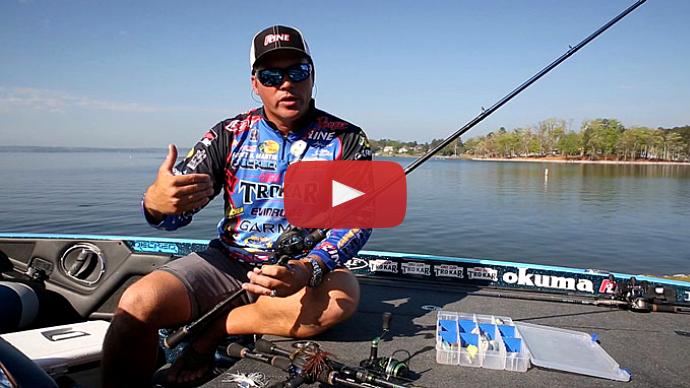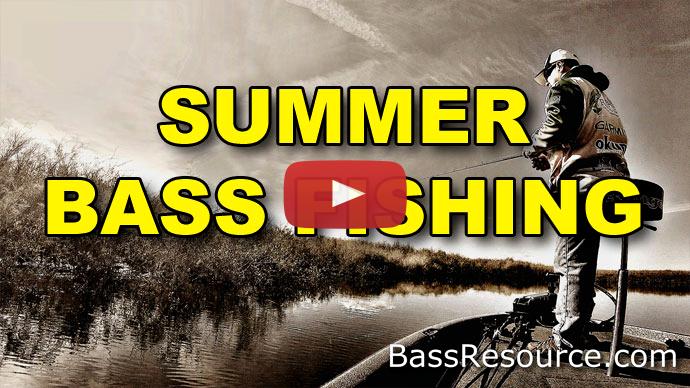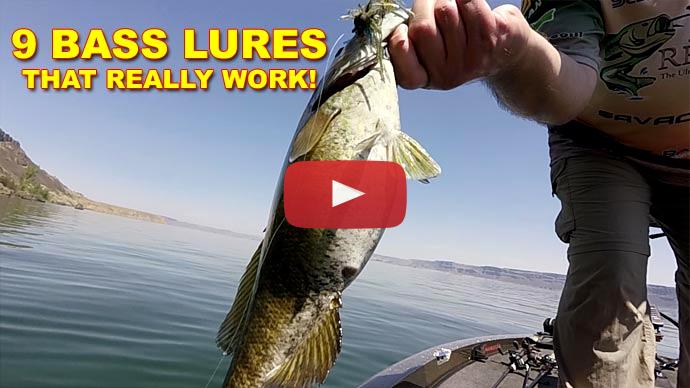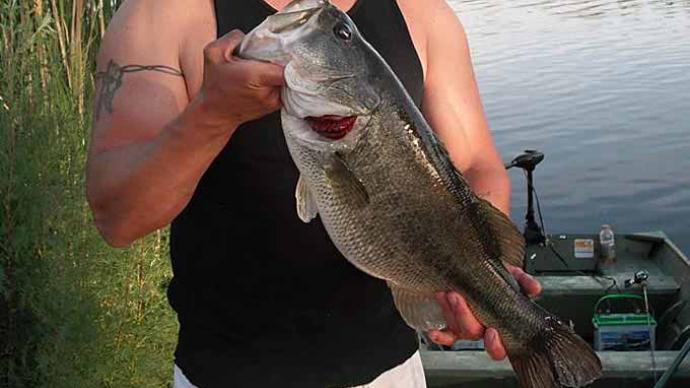Hey folks, Glenn May here with BassResource.com and today I'm gonna talk to you about summer fishing. Yeah, that great time when we catch a lot of fish, the weather's nice and calm, it has been stable now, we got past all those, you know, those fronts coming through in the spring, not so much rain. It's a great time to be out on the water. However, a lot of people noticed that the fishing seems to be a lot more difficult. Well let's talk a little bit about that, let's figure out what's going on.
So what happens in the spring is a lot of the fish they migrate up into shallow waters to spawn. So the majority of the population is up shallow. So you catch a lot of fish when you casting shallow. In the summer time, a lot of them will move back out either mid-depths or to deeper water. So a lot of people think well the fish have abandoned the shallows, they’re gone, you got to go fish deep. You're going to find articles that say that, okay. That's...that's not true. It's just that the majority of the fish aren't all up shallow now. Now they're scattered. This is what happens in the summertime.
You're gonna find a good population of fish that are shallow, but you'll also find just as many that will be mid-depth and in deep. So the key is, is trying to find them first of all and number two is see which ones are active that day. It's gonna change. So let's start off with, with the shallow fish.
What I like to do is, is I like to find lakes that have a lot of vegetation in them. If there's a lot of hydrilla, a lot of milfoil, coontail, lily pads, any kind of like this got a lot of vegetation like that. Those weeds create a lot of oxygen, a lot of shade, lot of shelter and lot of cover. Bait fish naturally go in there, and insects also feed and live in there. That's naturally gonna attract the bass. So those are areas to hit if your lake has a lot of weeds and stuff, focus on those areas during the summertime, you'd be really surprised how many fish are in there.
It just depends on the kind of weeds you have, whether you can hit it with, you know, you get a go punching with jigs and punch through that matted vegetation or if it's just under the surface, you might be able to bring a spinnerbait over the top of them or shallow diving crankbait, something like that. But that's the areas I would target if that's the majority of the cover available on the lake.
Now if your lake doesn't have a lot of vegetation, older reservoirs sometimes don't have that. Now you got to focus more on structure. And what I mean by structure, that's any kind of contour change on the bottom. You're looking for humps, ridges, ledges, drop-offs, creek channels, long tapering points, things like that is what you want to look for, for structure. Now one of the key things I like to look for when I'm looking for structure, I'm looking on a map or graph, or I'm just driving around the lake and looking. So I like to find structure that's near flats. It's got to have a flat nearby someplace, where they can go over and feed and then come back to that structure and feel comfortable in. So a hump or a point or a ridge, channel, a creek channel that comes in the bend that gets near a flat, that's an ideal place to look. Even if you're not marking fish on that...on those pieces or structure, definitely fish and you might catch fish there.
But don't just go to any structure and start fishing, "Hey, it's summertime, I got to fish deep. So I'm gonna go 30 feet deep and start fishing." Chances are you aren't gonna be successful that day.
What I like to do is when I first launch the boat, I flip on the graph, and I take a look to see if I can find any bait fish or any fish activity. Typical bait fish, you find a ball of fish somewhere, you know, bait fish at a certain depth. You don't always get that characteristic, you know, look on your depth finders. So typically what I do is I just try to find what's the average depth where I see most, the most activity? Let's just say, 15 feet, just for an example, the 15-foot mark. Then I'll go try to find structure that intersects with that depth. Be it a hump or some kind of a point, something like that, that's the area where I'll target first. I'll go out and fish that area, and I'll fish a little bit below and a bit above it to see if I can't catch fish there because bass...bass are gonna key on the bait fish. They wanna, their ambush, they're gonna use that, that structure to ambush those bait fish, so that's the that's the depth you wanna look at. You'd be a lot more successful if you just do a little bit of hunting with your graph and find that sweet spot and then start fishing those...those areas and fish anything that would get down to that depth.
So if your fishing 30 feet deep, it's hard to get down there with the spinnerbait, so you're fishing jigs, you're fishing football head jigs, you're fishing Carolina rigs, split shot, drop shot, anything that gets that bait down there and work that area. And you have to fish it according to how the fish bite. I'd like to go fast to slow, try to fish the fast moving bait if you're getting bites, great, but if you're not, then start slowing down till you get a bite and again fish in that depth zone, you'll figure it out.
But even if you find those humps and ridges and points and whatnot on your map, there's gonna be a sweet spot on it, and you're just gonna have to fish it to find that sweet spot. You're not gonna have guaranteed success that you've found a hump and start fishing and start catching fish. Fish those depths and find it when you catch a fish you want to note what depth they were at and where they were on that that piece of structure. There might be something there like a rock, like a log, maybe a patch of grass, something that's holding them and that's the sweet spot, that's the spot on the spot, and sometimes you can load up, fish might be stacked up on that one spot. So pay close attention to where you were, what position with your boat, where you made a cast and lock onto that to see if there's more fish sitting on that spot, you may find a honey hole there.
Now sometimes when I'm fishing a brand new lake, and I don't know anything about it, I don't know if it's got weeds in it or if it doesn't or what's going on, I have no idea what the pattern is, I even don't know how deep the lake is, is just go fish a point. Fish a long tapering point that goes down into deep water. Typically, I just launch the boat and the first point I come to, I start fishing it. What I'll do is I'll start off deep and work my way in shallow. I don't want to bring that boat right up on top of the fish. To fish that shallow water first, I might spook away all the fish that are positioned on that point. So I start off deep, I'm throwing like a football head jig, I'm throwing deep diving crankbaits, Carolina rig or split shot rig. I'll start off as deep as I need to depending on depth that...how deep that lake is and then start gradually working my way on up. I'll work one side of the point and then the other and then across it until I get...start getting shallow where I can start hitting it with different types of baits like spinnerbait, shallow or driving, diving crank baits or even top water baits. It's a great way to approach summer if you don't have a graph and not sure what's going on, I've been really successful doing that at a lot of different lakes. It's just a great way to start.
Now I want to talk a little bit about oxygen levels. Because that comes up a lot when you're talking about summertime fishing and how that affects positioning the bass. While it's true, as the water temperature rises above 80 degrees and starts getting warmer than that, it starts to lose its ability to hold oxygen. Don't key on that one factor as being okay, water temperature is 87 degrees that must mean all the fish are deep. That might not be the case. A couple of things to keep in mind. If there's lots of wind, you get the water churning up, and that's gonna oxygenate the water, it's gonna hold up more oxygen that way, even though the water temps up. And like I mentioned before, if you've got a lot of weeds and grass and vegetation, they produce oxygen. They also produce shade, and that means that the water underneath those mats of vegetation is a lot cooler, so will hold more oxygen.
So you want to fish, even if it's 80, 90-degree water temperature, pay attention to those factors because there could be a boatload of fish up in the shallows in those weeds, and you're out fishing 30 feet deep, and you're wondering why you're not catching fish, or you had a real windy day or it's windy right now and that's churning up the waves and getting a lot of oxygen in there and those, that might move all the fish up, the bait fish that knocks on the zooplankton down, the bay fish move up, the wind is oxygen in the water, the fish will be right in there and you can have really high water temperature. So don't key on just the water temperature and think all the oxygen level is low, I better not fish shallow, you might miss a good bite.
The other thing to keep in mind is what something that's called the thermocline. That sets up on a lot of lakes, not all of them. So don't think that because you can't find it on your depth finder, it means something's wrong. There are a lot of lakes where thermocline doesn't set up. But what that is, is as the summer progresses, the upper water level, it becomes more dense. When that happens, it's tougher and tougher for the oxygen to reach the lower depths of the water, of the lower water column. So at some level, you'll get pretty much even water temp, and then they'll be a short range where there'll be a quick water temp drop, and then it'll be a lot colder underneath it.
This is the layer...this middle layer that's basically a barrier if you will between the oxygen...water with oxygen in it and the water below it that doesn't have any. If...you can see that on the graph, you'll notice you'll see a really kind of a thick line that's a few feet deep. It's not black, but it's like a dark gray line, somewhere it's just right in the middle of the depth finder. There' nothing wrong with the depth finder, that's the thermocline. It's real important to note that because the water below that doesn't have a lot of oxygen, not enough to sustain life, not that the fish won't go there, they will for brief stints. They will go down in there, but they can't stay there for very long. So that means the majority of all the fish, if not all of them, are above that level. It's important to note that because again if you read the books and say "Oh, I got a fish deep in the summertime, I'm gonna go fish 30-40 feet deep, if that's thermoclines are 15-foot deep, you're never gonna get a bite. The baitfish aren't there. No bait fish, no bass, no bites, okay.
So you need to pay attention to that thermocline, and this can...it can get higher and higher up, and it could be only 7 feet deep, 6 feet deep in some lakes. This is why sometimes in the summertime, you can catch a bunch of fish really shallow during the heat of the day, the water temps are way up there. Why are the fish that shallow? Well, it's because that thermocline is really up there and there's no place else for them to go, even though it's not ideal, it doesn't have the ideal oxygen amount but below it is not at all, right? You can't get below that thermocline, they're not gonna live very long. So they will move up shallow if they have to.
So you've got to pay attention to multiple factors and trying to figure out what positions the fish. The weed cover that's availability...available, the structure, the time of day, oxygen level and also the sun, that positions the fish a lot too.
Look for the shady areas. If you fish say docks and you're fishing in the morning, you're catching fish on one side of the docks, pay close attention, lot of times that's the shady area of the dock, while as the day progresses, that shade is gonna shift as that sun moves through the sky, that's gonna reposition those fish or they might be on bushes or trees or what have you. Pay attention to where that shade is as it moves throughout the day and you can stay on top of those fish. So those are some of the tips for summer fishing. I hope those help. For more tips and tricks like this, visit BassResource.com.





